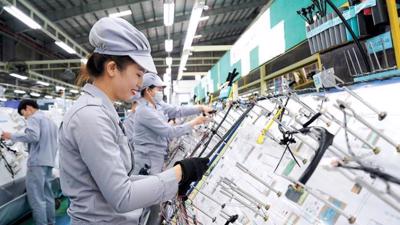Solutions for double-digit economic growth
Talk of double-digit economic growth in the years ahead must be backed by a break from the old models that have brought Vietnam to where it is today.

The 15th National Assembly (NA) passed a resolution in February to raise Vietnam’s GDP growth target to a minimum of 8 per cent in 2025 and then double-digit annual rates in the 2026-2030 period, revealing a high level of consensus across the political system regarding the country’s new development goals. According to many experts, however, accomplishing such goals will be extremely challenging given the current complex global landscape.
In order to realize such targets, Vietnam can no longer rely on the old economic model, which is heavily dependent upon low-cost labor, FDI, and public investment. Rather, a new development strategy is required, one that is grounded in robust institutional frameworks, advancements in science and technology, and a high-quality workforce.
Ambitious yet achievable
With Vietnam’s per capita income standing at some $4,700, the country is approaching a decisive crossroads. According to Dr. Vu Thanh Tu Anh, Senior Lecturer at the Fulbright School of Public Policy and Management, the economic direction Vietnam takes over the next 15 years will determine whether it can achieve developed nation status or continue down the path of moderate, prolonged middle-income growth. “A 6 per cent annual growth rate would lift Vietnam’s per capita income to $15,000,” he believes. “At 7 per cent, the country could edge into the lower tier of high-income economies. But only with sustained double-digit growth could it hope to hit $33,000; a threshold commonly associated with developed status.”
Achieving even 7 per cent growth, Dr. Tu Anh added, would demand a near 4 per cent annual increase in Total Factor Productivity (TFP); a level that few nations have managed in the modern era. The challenge is further compounded by Vietnam’s demographic shift. While the workforce was growing by 2 per cent each year two decades ago, today it expands by just 0.5 per cent, and is even projected to shrink in the years ahead. For Dr. Tu Anh, the implications are clear: Vietnam must rely less on workforce quantity and more on productivity to power future growth. “This is Vietnam’s No. 1 challenge,” he warned.
At the heart of the issue, he argued, is the need to transform the country’s economic structure and rebuild its development institutions. He proposed three foundational pillars: (1) A fully functioning market economy, where the private sector acts as the primary engine of growth; (2) A capable, enabling State, equipped with strong policy-making and implementation capacity; and (3) An inclusive institutional framework, which balances power control with incentives for innovation.
Regarding the first pillar, Dr. Tu Anh highlighted the significance of the Politburo’s recognition, for the first time, of the private sector as one of the key drivers of economic growth. However, he emphasized that Vietnam must go further, placing the private sector at the center of resource allocation and innovation leadership.
For the second pillar, he asserted that if Vietnam wants breakthrough development, the State must act as a facilitator, not as a barrier. “That requires building a professional, transparent, and accountable administrative apparatus,” he continued. Japan, South Korea, and Taiwan have already succeeded in this endeavor.
Lastly, for institutional inclusivity, he emphasized the need for a balance between political centralization and civil liberties, and between rule of law governance and market dynamism. Institutions must not only control corruption but also foster creativity and protect property rights.
Institutions and capital: Twin growth engines
According to Dr. Nguyen Dinh Cung, former Director of the Central Institute for Economic Management (CIEM), a prerequisite for achieving double-digit growth is that the ratio of total social investment to GDP must reach at least 40 per cent, and investment efficiency must improve significantly, with the current ICOR (Incremental Capital-Output Ratio) needing to fall from 6 to 4 or even less.
This translates into a pressing need to dramatically boost investment efficiency and encourage private sector investment, particularly in foundational industries and innovation. However, Dr. Cung emphasized that strong private investment cannot materialize if institutional bottlenecks remain in place.
He advocated for an expansionary fiscal policy. If the budget deficit cap is kept at 5 per cent of GDP, then government savings must reach at least 3 per cent, achieved through cutting back on regular expenditures. Yet this poses challenges, especially amid policy directions to offer free access to essential public services like healthcare and primary education.
He strongly endorsed Party General Secretary To Lam’s call for a more active role for the State in macro-economic regulation, ensuring a business-friendly environment and effective market mechanisms while promoting social equity. He stressed that this should be considered a core orientation for institutional reform and a guiding principle for reviewing and eliminating outdated or obstructive legal provisions.
He underscored the need to eliminate institutional barriers and abandon outdated mindsets such as “if it cannot be regulated, it must be banned” or “open investment only to the extent of State management capacity.” He called for the removal of ambiguous, discretionary administrative procedures, advocating instead for greater freedom for individuals and businesses to innovate and operate within the bounds of the law.
According to Dr. Cung, the law must harness the power of the people and all economic sectors by establishing an efficient, responsive public administration system and a transparent, low-cost business environment that meets international standards, thereby encouraging entrepreneurship and wealth creation.
He proposed a national program focused on entrepreneurship and private sector development, aiming to have at least 1.5 million active businesses by 2030. He also suggested establishing “institutional hotspots” - breakthrough zones for innovation - by upgrading and expanding current high-tech parks and launching new facilities.
These zones would benefit from preferential treatment in administrative procedures, tax policies, land access, and visa and residency regimes. Research, development, prototyping, and production would be allowed freely within clearly defined parameters. The government would support these efforts via national, sectoral, and local funding mechanisms for research and development (R&D).
Human capital: Growth cornerstone
Another key factor, as widely agreed by many scholars, is human capital. According to Dr. Tran Anh Tuan, Chairman of the Association for Administrative Sciences and former Deputy Minister of Home Affairs, all challenges and decisions ultimately revolve around people, making human resources the heart of the matter.
Dr. Tuan emphasized that revitalizing Vietnam’s education system is essential. This requires a clear separation between education and vocational training, the standardization of the teaching workforce, and a “demand-driven” mechanism linking enterprises with schools. Simultaneously, Vietnam must invest in high-quality human resources in strategic sectors and introduce new incentive policies to attract talent from both within and outside of the country.
In reality, many businesses today are forced to spend considerable time retraining newly-hired staff, particularly on basic skillsets that should have been developed in school. Therefore, improving educational quality is not just about knowledge but also about instilling ethics, responsibility, and the capacity to meet the growing standards of a digital society.
To address this, the education system must modernize its curricula, fostering creativity and critical thinking. Teacher qualifications and teaching methodologies also need to be upgraded in the context of digital transformation and AI. These efforts must go hand-in-hand with appropriate salary and incentive policies to motivate and retain educators, reducing the risk of systemic dysfunction.
Vocational training aligned with market needs is not a new concept. The real question is whether Vietnam’s current mindset towards education and training has truly evolved. More importantly, Dr. Tuan noted that policies must distinguish between attracting talent and effectively utilizing talent. He also stressed that scientific research should focus on real-world application, rather than remaining unused and archived after completion.
In the context of digital transformation, experts further emphasized the pivotal role of science, technology, and innovation. According to Associate Professor Le Bo Linh, former Vice Chairman of the NA’s Committee on Science, Technology and Environment, Vietnam has adopted many sound policies but still lacks an effective overarching strategy. He proposed unifying existing strategies into a single “National Strategy for Advancing Science, Technology, Innovation, and Digital Transformation by 2045”, with a strong focus on supporting tech enterprises, scaling up R&D investment, and developing national digital infrastructure.
Experts also agree that Vietnam must design its own development model, rather than replicating those of others. It is time to abandon the mindset of imitation and embrace the ambition of “leapfrogging technology” by seizing opportunities from new waves of industrial change.
Achieving double-digit growth would not be a miracle. It would be the outcome of a comprehensive restructuring strategy, led by a capable State, driven by an efficient market, energized by a dynamic private sector, and supported by a legal framework conducive to innovation. The ambition is there. What’s needed now is unwavering determination and coherent action during this critical phase.







